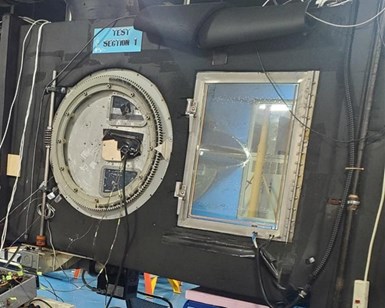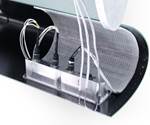Qarbon Aerospace successfully completes icing tunnel test for Helios system
Patented Helios Ice Protection technology uses an embedded heated graphite layer to heat composite structures significantly faster than legacy systems.
This image illustrates an ice shape at the maximum time between shed cycles at a relatively mild appendix C condition. The purpose is to determine a safe pulsing sequence to avoid large enough ice shape that could cause the aircraft to stall. Helios can pulse in such a way that has proven greater than 50% power efficiency since inception thanks to continuous development. Photo Credit, all images: Qarbon Aerospace.
(Red Oak, Texas, U.S.) has successfully completed another icing tunnel test of the company’s patented Helios Ice Protection system. The technology uses a heated graphite layer embedded in a thermoplastic composite leading edge. The graphite’s thermal conductivity is said to produce heat significantly faster than legacy ice protection systems, which is a crucial benefit in ice protection technologies.
The Helios test articles used for the icing tunnel test used Teijin (Tokyo, Japan) carbon fiber materials and Web Industries’ (Marlborough, Mass., U.S.) Precision BiasPly technology. The patented technology produces bias-ply composites that enable high-scale production in application-specific formats, increasing efficiency and reducing waste.

Illustrated here is Qarbon’s test article mounted to a closed-loop icing wind tunnel able to test various CFR part 25 appendix C and few appendix O conditions.
According to Qarbon Aerospace, the successful Helios icing tunnel test validated a manufacturing concept for advanced manufacturing processes and low electrical power requirements. The Helios Ice Protection electro-thermal system replaces bulky rubber pneumatic boots, gates, valves, tubing, controller, hardware and nacelle heating systems.
Qarbon Aerospace is a provider of large, complex composite and metallic structural components and assemblies such as fuselages, wings, flight control surfaces, and engine nacelles and components. Qarbon Aerospace operates nearly two million square feet of factory space across three facilities located in Red Oak, Texas; Milledgeville, Georgia; and Rayong, Thailand.
The company has vertically integrated manufacturing capabilities from component fabrication through large-scale assembly as well as proprietary thermoplastics technologies. Such technologies are being used to inform or develop advanced structures in civilian vertical life vehicles, the HEXA eVTOL aircraft and Virgin Galactic’s Delta-class spaceships.
Related Content
-
Infinite Composites: Type V tanks for space, hydrogen, automotive and more
After a decade of proving its linerless, weight-saving composite tanks with NASA and more than 30 aerospace companies, this CryoSphere pioneer is scaling for growth in commercial space and sustainable transportation on Earth.
-
Welding is not bonding
Discussion of the issues in our understanding of thermoplastic composite welded structures and certification of the latest materials and welding technologies for future airframes.
-
Plant tour: Airbus, Illescas, Spain
Airbus’ Illescas facility, featuring highly automated composites processes for the A350 lower wing cover and one-piece Section 19 fuselage barrels, works toward production ramp-ups and next-generation aircraft.






